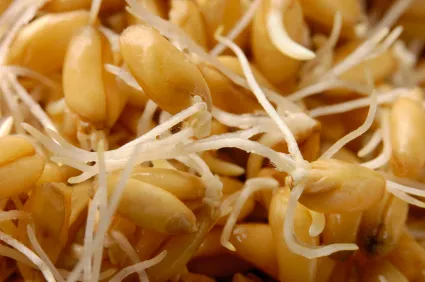
Sprouting Seeds and Grains
Seeds and grains (the seeds of grain plants) are specially designed to survive unchanged in nature until they land in a situation just ripe for starting a new version of whatever plant they come from. The vital nutrients for growth stay encased in a fairly impermeable shell until the seed arrives in a place both moist and slightly acidic, optimal growing conditions. Over a period of hours or days the shell is gently softened and opened and the activated nutrients enable the seed to grow.
When we eat seeds and grains, the same thing happens: the seed arrives in a nice moist environment, passes through the nutrient-absorbing part of our digestive tract with its shell just beginning to soften, and then when it reaches the colon, the shell gradually opens and the seed’s contents are accessible. Unfortunately it’s too late to be of nutritional value. Meanwhile the seed’s shell has had a disruptive effective on other nutrients around the seed. And we don’t really want things sprouting in our colon.
So all grains and seeds should undergo some degree of sprouting before we eat them. Simple conclusion and simple task.
Cooking and Eating Grains
The only modification required to optimize cooking with grains or seeds is to introduce soaking as a pre-step. Simply combine the grains and the water they are to be cooked in for 6-24 hours before cooking. Soak the morning oatmeal the night before, and while you’re heating it up in the morning, put the evening’s rice into water. Adding a little acid to the water (whey, lemon juice, or vinegar) will not affect taste but will enhance the process. If your recipe calls for the rice to be cooked in broth, you can soak it in water in the morning, and drain before cooking: there are no significant nutrients lost into the water in the soaking process. Your grains will taste about the same to your mouth, but be much better received in your intestines.
Flour makers have the chance to follow a similar process: soaking first, then draining and drying the sprouted grains to make into flour. You can buy sprouted flour (note recipe adjustments on the package) in health food stores and sprouted grain products in most stores.
Eating Sprouts
Sprouts are a highly nutritious form of seeds and grains, harboring the full potential for growth with a lower starch content than the fully grown grain.
Thanks to Sally Fallon and Nourishing Traditions cookbook for the following instructions on home sprouting:
“No special equipment is required to transform grains and seeds into sprouts – just wide-mouth, quart-sized mason jars with a round of window screen material cut to fit into the lid of the jar, replacing the solid insert.
The method for sprouting all grains and seeds is the same – only the length of time needed to accomplish full germination varies with the size and nature of the seed. Simply fill a mason jar one-third full with any grain or seed. Add filtered water to the top of the jar and screw on the top with its screen insert. Allow the seeds to soak overnight and pour off the water. Rinse the seeds well – you can do this without removing the top. Invert the jar and let it sit at an angle so it can drain, and to allow it to circulate. The seeds should be rinsed every few hours, or at least twice a day. In one to four days the sprouts will be ready. Rinse well, shake out excess moisture, and replace the screen insert with the solid section of the lid. Store the sprouts in the refrigerator.
Almost any grain or seed can be sprouted – wheat, barley, dried beans, radish seeds, onion seeds, chia seeds, chickpeas and almonds. Fragile seeds such as pumpkin and sunflower also sprout nicely. Hulled seeds should be purchased in tightly sealed packages and not from open bins, so that oxidation is minimized.”

